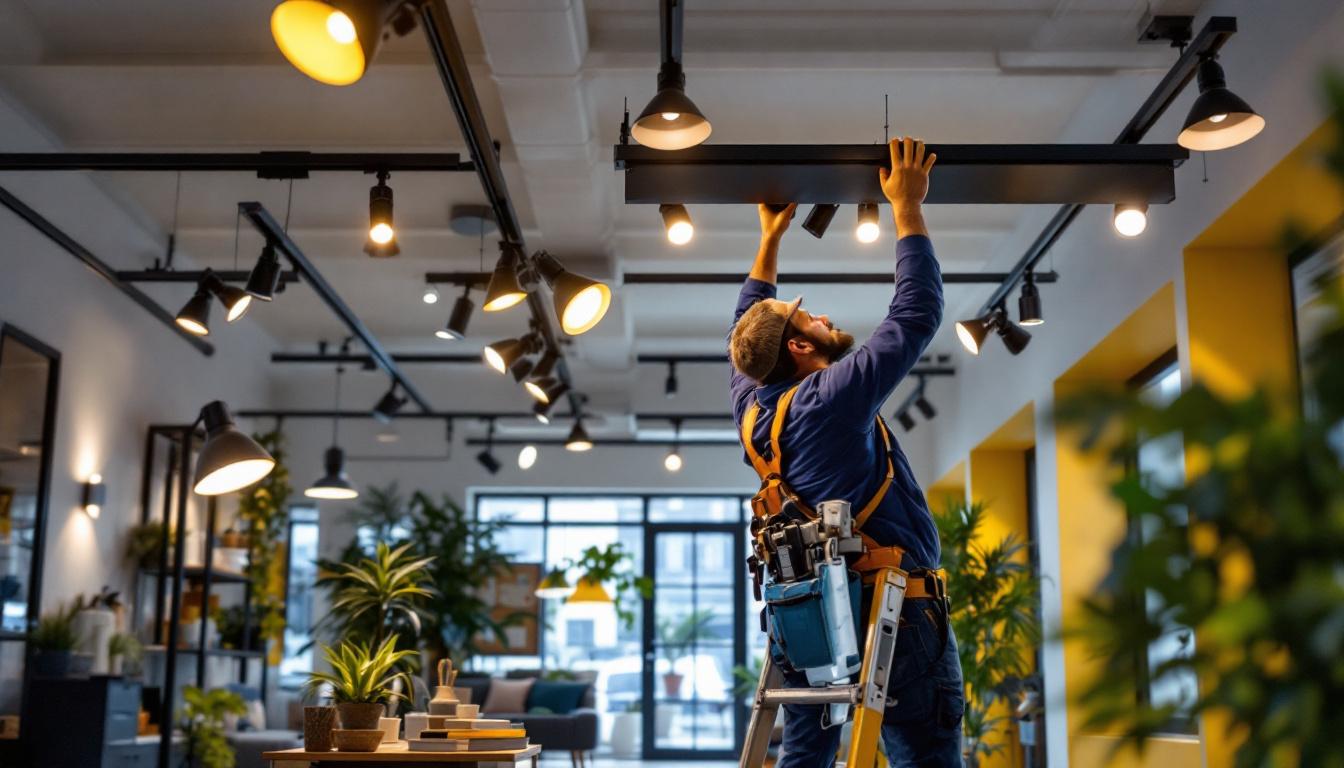
When specifying lighting solutions, contractors often encounter a variety of bulb types, each with unique characteristics. The C light bulb, recognizable by its tubular shape bent into a “C,” is a staple in commercial and residential lighting due to its efficiency and versatility. However, its design and application nuances require a clear understanding to maximize performance and client satisfaction.
The C bulb is typically a fluorescent or LED tube bent into a semi-circle, designed to fit fixtures where linear tubes won’t fit or where a specific light distribution pattern is needed. Its compact form factor allows for innovative fixture designs, particularly in decorative or confined spaces. For lighting contractors, knowing the exact specifications, compatibility, and installation requirements is crucial to avoid costly mistakes or suboptimal lighting.
One of the key advantages of C bulbs is their ability to provide uniform light output in compact fixtures, making them ideal for under-cabinet lighting, display cases, and even some ceiling fixtures. They often come in various wattages and color temperatures, allowing contractors to tailor lighting solutions to client needs, whether that’s warm, inviting light for hospitality settings or bright, clear illumination for retail environments.
In addition to their aesthetic appeal, C light bulbs are also lauded for their energy efficiency. With advancements in LED technology, these bulbs consume significantly less power than traditional incandescent options while providing the same or even greater light output. This not only translates to lower energy bills for clients but also contributes to sustainability goals, making them an attractive choice for environmentally conscious consumers. Furthermore, the longevity of C bulbs, particularly LEDs, means reduced maintenance costs and less frequent replacements, a crucial consideration for contractors managing large-scale projects.
Moreover, understanding the dimming capabilities of C bulbs can further enhance their application. Many modern C LED bulbs are compatible with dimmer switches, allowing for adjustable lighting levels that can create the perfect ambiance for any setting. This flexibility is particularly beneficial in spaces that serve multiple functions, such as restaurants that transition from bright, vibrant lighting during the day to softer, mood-enhancing illumination in the evening. By staying informed about the latest dimming technologies and compatible fixtures, contractors can offer clients a more customized lighting experience that meets their specific needs and preferences.
Before selecting a C light bulb, contractors must evaluate the environment where it will be installed. Factors such as fixture design, space constraints, and lighting goals heavily influence the choice. For example, in tight spaces where linear tubes are impractical, a C-shaped bulb can fit perfectly without compromising on brightness or energy efficiency.
Consider also the ambient conditions. If the installation is in a damp or temperature-sensitive environment, choosing bulbs rated for those conditions is essential. Some C bulbs come with enhanced coatings or are designed to operate efficiently in cooler or warmer temperatures, which can extend their lifespan and improve performance. Furthermore, understanding the color temperature of the light is crucial; warmer tones can create a cozy atmosphere, while cooler tones are often preferred for task-oriented spaces, such as kitchens or workshops. This consideration can significantly impact the overall aesthetic and functionality of the area being illuminated.
Not all C light bulbs are interchangeable. The base type, length, and wattage must align with the fixture’s specifications. Common bases include bi-pin or single-pin configurations, and mismatching these can lead to installation headaches or electrical issues. Additionally, the bulb’s length and curvature must fit the fixture’s socket and housing. It’s advisable to consult the fixture’s manual or manufacturer guidelines to ensure compatibility, as this can prevent costly mistakes and ensure optimal performance.
Energy consumption is another critical factor. Many modern C bulbs utilize LED technology, offering significant energy savings compared to traditional fluorescent options. Contractors should calculate the total wattage and lumens output to ensure the lighting system meets both client expectations and energy codes. Moreover, it’s worth noting that the efficiency of LED C bulbs can also lead to reduced heat output, which is beneficial in maintaining comfortable temperatures in enclosed spaces. This energy efficiency not only contributes to lower utility bills but also aligns with sustainability goals, making it an attractive option for environmentally conscious clients. As energy regulations continue to evolve, staying informed about the latest standards can help contractors recommend the best solutions for their projects.
Handling C light bulbs requires care due to their shape and fragility. Unlike standard linear tubes, the curved design can make them more susceptible to damage if mishandled. Wearing gloves and using proper support during installation reduces the risk of breakage and contamination, which can affect bulb performance. Additionally, it’s advisable to inspect the bulb for any visible defects before installation; even minor imperfections can lead to premature failure or safety hazards once the bulb is powered on.
Safety is paramount. Always ensure power is disconnected before installation or replacement. Some C bulbs operate on high voltages or require specific ballasts; understanding the electrical requirements prevents accidents and ensures compliance with electrical codes. Furthermore, consider using a voltage tester to double-check that the power is off, as this extra step can provide peace of mind and enhance safety during the installation process. Properly disposing of old bulbs, especially those containing hazardous materials, is also crucial to protect both the environment and personal safety.
Proper seating of the bulb in the fixture is critical. Loose connections can cause flickering or intermittent operation, which clients often find frustrating. Verify that the bulb snaps or twists securely into place and that the fixture’s ballast or driver is compatible with the bulb type. In addition, ensure that the bulb is rated for the specific environment it will be used in; for example, some bulbs are designed for damp locations while others are suitable for dry areas only. This attention to detail can significantly impact the longevity and reliability of the lighting solution.
For LED C bulbs, confirm that the fixture’s dimming controls, if present, are compatible. Incompatible dimmers can cause buzzing or reduced bulb lifespan. Testing the bulb in the fixture before finalizing installation can save time and reduce callbacks. Moreover, consider the color temperature of the bulb, as this can greatly influence the ambiance of the space. Warmer tones create a cozy atmosphere, while cooler tones can enhance productivity in workspaces. Taking the time to select the right color temperature ensures that the lighting not only functions well but also complements the intended use of the area.
Regular inspection and cleaning can significantly extend the life of C light bulbs. Dust and debris accumulation can reduce light output and cause overheating. Use a soft, dry cloth to clean bulbs during routine maintenance, avoiding harsh chemicals that may damage coatings. Additionally, consider the environment in which the bulbs are used; areas with high humidity or temperature fluctuations can affect bulb longevity. Installing bulbs in well-ventilated fixtures can help dissipate heat more effectively, further prolonging their lifespan.
For fluorescent C bulbs, periodic ballast checks are advisable since ballast failure is a common cause of bulb flickering or failure. Upgrading to LED C bulbs can reduce maintenance frequency and improve energy efficiency, though initial costs may be higher. LED bulbs not only last longer but also provide instant brightness and come in a variety of color temperatures, allowing for greater customization of your lighting environment. Furthermore, many LED options are now designed to be dimmable, which can enhance the ambiance of a space while still being energy-efficient.
Flickering is a frequent complaint with C light bulbs. Causes range from loose connections to incompatible ballasts or dimmers. Start troubleshooting by checking the bulb’s seating and wiring integrity. If the problem persists, testing the ballast or replacing it with an LED driver may be necessary. In some cases, the flickering may be due to voltage fluctuations in your electrical system, which can be addressed by consulting a qualified electrician to ensure your home’s wiring is up to code and functioning properly.
Another issue is uneven light output, often caused by bulb degradation or fixture damage. Replacing the bulb with a high-quality, compatible model usually resolves this. For persistent problems, inspect the fixture’s reflector and diffuser for damage or dirt buildup. It’s also worth noting that using bulbs of varying brands or types in the same fixture can lead to inconsistent performance; therefore, it’s advisable to use bulbs from the same manufacturer to ensure uniformity in light output and color consistency. Additionally, consider the wattage and lumens of the bulbs being used, as mismatched specifications can contribute to uneven lighting and overall dissatisfaction with your lighting setup.
Energy efficiency is a top priority for contractors and clients alike. LED C bulbs have transformed the market by offering up to 75% energy savings compared to traditional fluorescents. Their longer lifespan also reduces replacement frequency, lowering labor costs over time.
When designing lighting systems, contractors should consider integrating sensors and controls with C bulb fixtures. Motion sensors, daylight harvesting, and smart controls can optimize energy use without sacrificing comfort or aesthetics. These technologies are increasingly compatible with LED C bulbs, providing a modern, efficient lighting solution.
The C light bulb is more than just a niche product; it’s a versatile tool that lighting contractors can leverage to meet diverse client needs. Understanding its specifications, installation nuances, and maintenance requirements ensures reliable performance and client satisfaction.
By selecting the right C bulb for each application, following best installation practices, and embracing energy-efficient technologies, contractors can deliver lighting solutions that stand the test of time. Mastery of the C light bulb is a valuable skill set that enhances any contractor’s portfolio and reputation in the competitive lighting market.
Ready to elevate your lighting game with the versatile C light bulb? At LumenWholesale, we provide lighting contractors like you with the highest quality, spec-grade lighting products at prices that can’t be beaten. Say goodbye to local distributor markups and hello to our extensive selection of reliable, high-performance lighting solutions. With free shipping on bulk orders, LumenWholesale is your go-to source for premium lighting without the premium price tag. Don’t compromise on quality or value; visit LumenWholesale for Wholesale Lighting at the Best Value and bring unparalleled efficiency and style to your next project.

Discover the ultimate Satco Track Lighting guide for lighting contractors, highlighting installation tips, benefits, and industry insights to elevate your projects—learn more now!.

Discover how solar cell lights are revolutionizing the lighting industry by enhancing efficiency and sustainability for contractors.

Discover essential tips and guidelines for lighting contractors navigating the online LED market in California.

Discover expert insights and practical tips on the Feit LED Shop Light tailored specifically for lighting contractors.